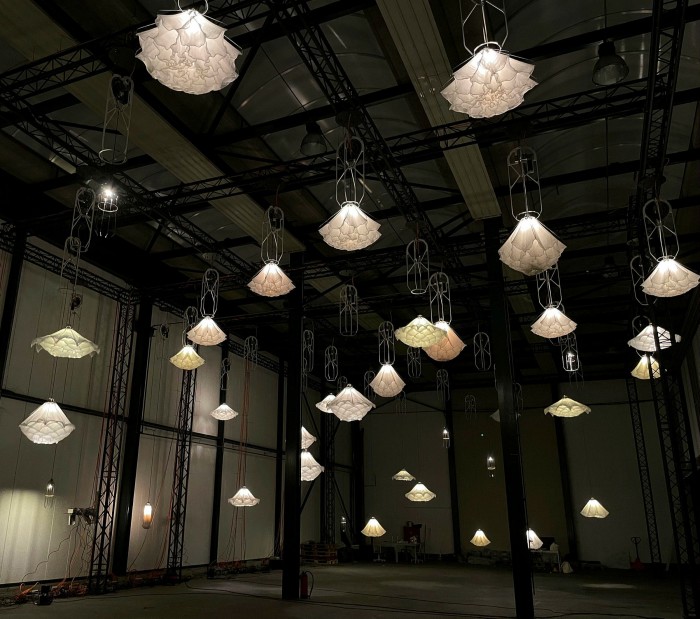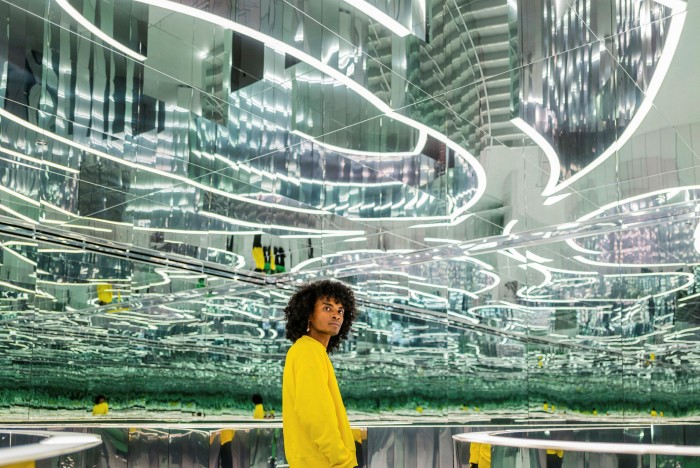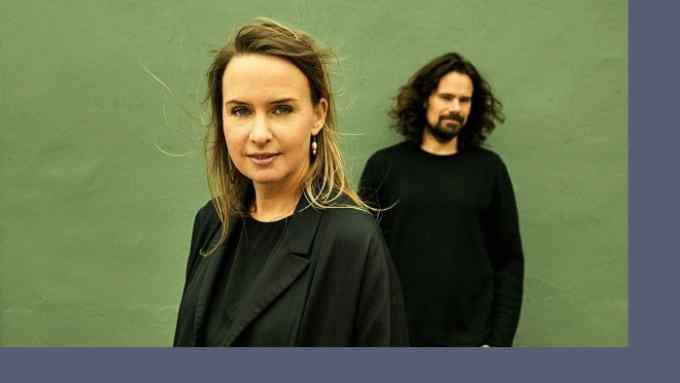Drift and Superblue offer experiential art at Design Miami/Basel

Roula Khalaf, Editor of the FT, selects her favourite stories in this weekly newsletter.
Lonneke Gordijn and Ralph Nauta — the Dutch founders of experiential-art outfit Drift — have ways of making things move. Under their stealthy conceptual and technological guidance, large concrete blocks float in the air and hundreds of drones swarm skywards in patterns originally choreographed by starlings.
“There’s certainly entertainment in what we do,” says Gordijn, “the Instagrammable part.” But more important to the pair is a desire to raise questions. “We want to make the viewer aware that they have a choice to break out of the systems they live in, that the world they live in is just one version of what is possible,” says Nauta.

This coming week, visitors to Design Miami in Basel will find themselves immersed in a Drift installation as they make their way to the fair. In the exhibition hall’s gaping ground floor, dozens of delicate silken lights will rise and fall, open and close, mimicking the process of nyctinasty found in plants — the rhythm which makes them unfurl in daylight and recurl as darkness falls.
“It will be a success if it makes people stop and change pace, before they make their way into the fair,” says Gordijn of this visual and spiritual massage. “There’s too much fast culture. Swipe, swipe, swipe. I hope it opens up space and time. It’s so important to calm down the mind.”

The Shylights, as these blossoming lanterns are called, have been part of Drift’s repertoire since 2006, evolving into an evermore seamless and lyrical performative piece. “It’s the project that’s taught us the most about mechanics,” says Gordijn. “At first they worked with simple motors, then we developed a circuit board and so on. It must have been redefined five or six times. But in the end it’s not about the technology, it’s about how it moves.”
The objective of Nauta, 43, and Gordijn, 41, is not to replace the natural world with a robotic version but to remind us how sophisticated, valuable and adaptive that world already is. “As humans, we get stuck in our existing systems and don’t know how to get out of them,” says Gordijn. “Instead of letting go of structures, we build on the old ones. Our work is about letting go and getting new perspectives. Looking at nature is hopeful.”

A piece called “Coded Coincidence” is composed of hundreds of tiny floating lights circulating in the air, before fading and falling to the ground; they emulate the flight patterns of elm seeds which take advantage of particular springtime winds for scattering. “For me, ‘Coded Coincidence’ is about how we are meant to have new encounters,” says Gordijn. A new version of it will be premiered on September 29 at The Shed in New York as part of Fragile Future, an exhibition of Drift’s work.
As exponents of immersive artworks, Drift is part of a growing group of artists offering experience over object, and now an initiative has emerged to give them a platform. Superblue, a for-profit business staging immersive art installations, was launched in Miami this April, with 50,000 sq ft of a former fruit warehouse in the city’s quickly gentrifying Allapattah neighbourhood for a paying public. (The artists receive royalties from this income.) It’s also responsible for bringing Drift to Basel.
Although a new enterprise, Superblue is no art-world outlier. Its chief executive is Mollie Dent-Brocklehurst, who has worked in the past for mega-galleries Gagosian and Pace. Dent-Brocklehurst identified an increasing interest in this kind of work and a need to make its production and distribution viable, so set up Superblue. “We’re selling experience,” she says.

In Miami, its space has four presentations including a dazzling mirrored maze by the theatre designer Es Devlin and one by Japan’s teamLab where visitors are enveloped in a room of soap bubbles. “It makes you strangely euphoric,” says Dent-Brocklehurst.
Superblue’s intention is to open further large venues around the world in major cities. In the meantime, along with Drift in Basel, it will also have a small-scale London launch during the Frieze art fair in October, when AA Murakami will present another multisensory experience in the former Pace gallery in Burlington Gardens. A landscape of artificial trees will release bursting bubbles filled with natural scents such as moss and pine.

Nauta and Gordijn recently took their 40-strong young studio team out of Amsterdam for a picnic in the countryside. “We stayed overnight on a campsite and cooked on fires, played games and got lost in the woods,” says Gordijn. “It’s amazing how quickly being immersed in nature awakens an intuitive part of yourself.” For the Basel audience, let’s hope a turn in the forest of tech will do the trick.
‘Shy Synchrony’, Design Miami/Basel, September 21-26, designmiami.com
‘Fragile Future’, September 29-December 19, theshed.org
Superblue.org

Comments